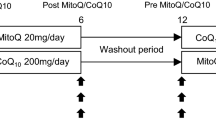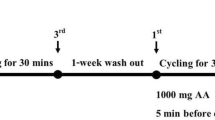Abstract
Mitochondrial diseases are due to impairment of the mitochondrial respiratory chain. A plausible pathogenic mechanism leading to cellular dysfunction and phenotypic expression is oxidative stress, but there are surprisingly few clinical studies on this subject. Glutathione (GSH) deficiency has been reported in mitochondrial diseases, and the biosynthesis of glutathione depends on cysteine availability. We have examined oxidative stress biomarkers [advanced oxidation protein products (AOPP) and ferric reducing antioxidant power (FRAP)] in blood samples from 27 patients and 42 controls. AOPP levels were greater in patients than in controls (P value <0.00001). Therefore, we performed a double-blind cross-over study to evaluate if 30-day supplementation with a whey-based cysteine donor could modify these markers, reduce lactate concentration during aerobic exercise, or enhance muscular strength and quality of life. Treatment did not modify lactate concentration, clinical scale (MRC) or quality of life (SF-36), but significantly reduced oxidative stress levels. Our findings reinforce the notions that in mitochondrial diseases oxidative stress is important and can be reduced by administration of a cysteine donor. Oxidative stress biomarkers may be useful to detect redox imbalance in mitochondrial diseases and to provide non-invasive tools to monitor disease status.



Similar content being viewed by others
References
Apolone G, Mosconi P (1998) The Italian SF-36 Health Survey: translation, validation and norming. J Clin Epidemiol 51:1025–1036
Atkuri K, Cowan TM, Kwan T, Ng A, Herzenberg LA, Herzenberg LA, Enns GM (2009) Inherited disorders affecting mitochondrial function are associated with glutathione deficiency and hypocitrullinemia. Proc Natl Acad Sci USA 106:3941–3945
Baker MA, Cerniglia GJ, Zaman A (1990) Microtiter plate for the measurement of glutathione and glutathione disulfide in large numbers of biological samples. Anal Biochem 190:360–365
Benzie IF, Strain JJ (1996) The ferric reducing ability of plasma (FRAP) as a measure of antioxidant power: the FRAP assay. Anal Biochem 239:70–76
Bernier FP, Boneh A, Dennett X, Chow CW, Cleary MA, Thorburn DR (2002) Diagnostic criteria for respiratory chain disorders in adults and children. Neurology 59:1406–1411
Chan DC (2006) Mitochondria: dynamic organelles in disease, aging, and development. Cell 125:1241–1252
DiMauro S, Schon EA (2003) Mitochondrial respiratory-chain diseases. N Engl J Med 348:2656–2668
DiMauro S, Servidei S, Zeviani M, DiRocco M, DeVivo DC, DiDonato S, Uziel G, Berry K, Hoganson G, Johnsen SD (1987) Cytochrome c oxidase deficiency in Leigh syndrome. Ann Neurol 22:498–506
DiMauro S, Tay S, Mancuso M (2004) Mitochondrial encephalomyopathies: diagnostic approach. Ann NY Acad Sci 1011:217–231
Guohua C, Prior RL (1998) Comparison of different analytical methods for assessing total antioxidant capacity of human serum. Clin Chem 44:1309–1315
Gutteridge JM (1995) Lipid peroxidation and antioxidants as biomarkers of tissue damage. Clin Chem 41:181–1828
Halliwell B, Gutteridge JM (1995) The definition and measurement of antioxidants in biological systems. Free Radic Biol Med 18:125–126
Hargreaves IP, Sheena Y, Land JM, Heales SJ (2005) Glutathione deficiency in patients with mitochondrial disease: implications for pathogenesis and treatment. J Inherit Metab Dis 28:81–88
Heinecke JW, Li W, Daehnke HD, Goldstein JA (1993) Dityrosine, a specific marker of oxidation, in synthesized by the myeloperoxidasehydrogen peroxide system of human neutrophils and macrophages. J Biol Chem 268:4069–4077
Lands LC, Grey VL, Smountas AA (1999) Effect of supplementation with a cysteine donor on muscular performance. J Appl Physiol 87:1381–1385
Medical Research Council (1943) Aids to the investigation of peripheral nerve injury. War memorandum, 2nd edn. HMSO, London, pp 11–46
Medved I, Brown MJ, Bjorksten AR, Murphy KT, Petersen AC, Sostaric S, Gong X, McKenna MJ (2004) N-acetylcysteine enhances muscle cysteine and glutathione availability and attenuates fatigue during prolonged exercise in endurance-trained individuals. J Appl Physiol 97:1477–1485
Navarro A, Boveris A (2007) The mitochondrial energy transduction system and the aging process. Am J Physiol Cell Physiol 292:C670–C686
Quinzii CM, Lopez LC, Von-Moltke J, Naini A, Krishna S, Schuelke M, Salviati L, Navas P, DiMauro S, Hirano M (2008) Respiratory chain dysfunction and oxidative stress correlate with severity of primary CoQ10 deficiency. FASEB J 22:1874–1885
Reid MB, Stokic DS, Koch SM, Khawli FA, Leis AA (1994) N-acetylcysteine inhibits muscle fatigue in humans. J Clin Investig 94:2468–2474
Ronald L, Guohua C (1999) In vivo total antioxidant capacity: comparison of different analytical methods. Free Radic Biol Med 27:1173–1181
Schaefer AM, McFarland R, Blakely EL, He L, Whittaker RG, Taylor RW, Chinnery PF, Turnbull DM (2008) Prevalence of mitochondrial DNA disease in adults. Ann Neurol 63:35–39
Schaefer AM, Phoenix C, Elson JL, McFarland R, Chinnery PF, Turnbull DM (2006) Mitochondrial disease in adults: a scale to monitor progression and treatment. Neurology 66:1932–1934
Siciliano G, Piazza S, Carlesi C, Del Corona A, Franzini M, Pompella A, Malvaldi G, Mancuso M, Paolicchi A, Murri L (2007) Antioxidant capacity and protein oxidation in cerebrospinal fluid of amyotrophic lateral sclerosis. J Neurol 254:575–580
Siciliano G, Renna M, Manca ML, Prontera C, Zucchelli G, Ferrannini E, Murri L (1999) The relationship of plasma catecholamine and lactate during anaerobic threshold exercise in mitochondrial myopathies. Neuromuscul Disord 9:411–416
Siciliano G, Tessa A, Petrini S, Mancuso M, Bruno C, Grieco GS, Malandrini A, DeFlorio L, Martini B, Federico A, Nappi G, Santorelli FM, Murri L (2003) Autosomal dominant external ophthalmoplegia and bipolar affective disorder associated with a mutation in the ANT1 gene. Neuromuscul Disord 13:162–165
Tietze F (1969) Enzymic method for quantitative determination of nanogram amounts of total and oxidized glutathione: applications to mammalian blood and other tissue. Anal Biochem 27:502–522
Turrens JF (2003) Mitochondrial formation of reactive oxygen species. J Physiol 552:335–344
Verkaart S, Koopman WJ, van Emst-de Vries SE, Nijtmans LG, van den Heuvel LW, Smeitink JA, Willems PH (2007) Superoxide production is inversely related to complex I activity in inherited complex I deficiency. Biochim Biophys Acta 1772:373–381
Vives-Bauza C, Gonzalo R, Manfredi G, Garcia-Arumi E, Andreu AL (2006) Enhanced ROS production and antioxidant defenses in cybrids harbouring mutations in mtDNA. Neurosci Lett 391:136–141
Witko-Sarsat V, Friedlander M, Capeillere-Blandin C, Nguyen-Khoa T, Nguyen AT, Zingraff J, Jungers P, Descamps-Latsch B (1996) Advanced oxidation protein products as a novel marker of oxidative stress in uremia. Kidney Int 49:1304–1313
Acknowledgments
The authors are grateful to Professors Salvatore DiMauro and Michio Hirano (Columbia University, New York) for their critical reading of the manuscript. This work was performed in the frame of AMBISEN Center, High Technology Center for the study of the Environmental Damage of Endocrine and Nervous System, University of Pisa.
Author information
Authors and Affiliations
Corresponding author
Electronic supplementary material
Below is the link to the electronic supplementary material.
Rights and permissions
About this article
Cite this article
Mancuso, M., Orsucci, D., LoGerfo, A. et al. Oxidative stress biomarkers in mitochondrial myopathies, basally and after cysteine donor supplementation. J Neurol 257, 774–781 (2010). https://doi.org/10.1007/s00415-009-5409-7
Received:
Revised:
Accepted:
Published:
Issue Date:
DOI: https://doi.org/10.1007/s00415-009-5409-7




